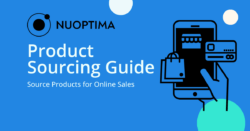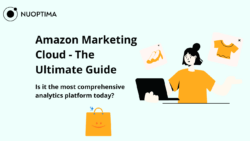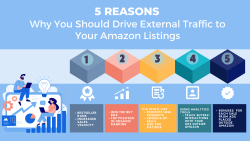Welcome, savvy e-commerce warriors! As you’re well aware, the battlefield of online sales is fiercely competitive. With Amazon as the juggernaut it is, ignoring its potential is like leaving money on the table. That’s why mastering the art of PPC (Pay-Per-Click) campaigns is essential for anyone looking to make their mark in today’s digital marketplace.
But advertising isn’t a walk in the park, is it? The challenges are numerous, from staying ahead of your competitors to fighting the uphill battle of keyword bidding. That’s precisely why understanding Amazon PPC campaign structure is so crucial – it’s your strategy, game plan, and roadmap all rolled into one.
So, if you’ve ever wondered how to structure a campaign like the specialists at our award winning Amazon PPC agency, you’ve landed in the right spot. We’re about to deep-dive into every nook and cranny of the PPC account structure on the marketplace, offering actionable tips. Whether you’re an e-commerce newbie or an advertising veteran, there’s something here for you. Ready to take the plunge? Let’s go!
The Significance of an Amazon PPC Campaign Structure
We’ve all been there – aimlessly setting up an ad campaign, crossing our fingers, and hoping for the best. But let’s face it, hope is not a strategy. A poorly set up ad is akin to throwing darts in the dark; you’re not likely to hit the target. Without a well-thought-out PPC account structure, you risk blowing your budget on irrelevant clicks, getting lost in the sea of competitors, or, even worse, becoming virtually invisible to your potential customers.
Now, let’s shift gears and imagine a world where your ad is as neat as a British garden. What does that look like for you as a seller?
- Precision Targeting: Proper Amazon PPC campaign structure allows you to segregate your ad groups efficiently, focusing on specific product attributes or shopper needs. This laser focus means you’re reaching the right audience at the right time.
- Optimised Budgeting: When you know how to structure Amazon PPC campaigns, especially by category, you can allocate budgets with finesse. That way, you ensure your high-performing search terms get the love they deserve without overshadowing the lower-volume but equally valuable phrases.
- Enhanced Visibility: Well-structured ads are more likely to achieve high-quality impressions, significantly boosting visibility. The greater the exposure your product receives, the higher the likelihood of driving conversions.
- Data-Driven Decision Making: With a pre-planned approach, your Amazon PPC strategy template becomes a treasure trove of useful data. You can then analyse this information to make informed decisions rather than taking stabs in the dark.
- Streamlined Operations: Think of an ordered account as a tidy office. When everything is in its place, managing, updating, or scaling your paid ads is easier.
- Impact on Sales: The end game of any ad is to boost sales and brand awareness. A well-crafted set up serves as the backbone for achieving these objectives.
The bottom line is that your campaign isn’t just a set of ads; it’s an ecosystem that needs balance and format. By understanding the difference between a campaign and an ad group, how to set up ad groups based on keyword types, and optimising your paid search campaign, you not only set yourself up for success but also create a sustainable and scalable sales machine.
How to Structure an Amazon PPC Campaign?
Alright, let’s roll up our sleeves and get to the heart of the matter – how to structure an Amazon PPC campaign effectively. Think of your account set up as a tree. At the top, you’ve got the campaign, the trunk that holds everything together. Sprouting from this trunk are various branches or ad groups, each with its own set of leaves – your keywords. The better you nurture this tree, the more fruitful it will be. Simple, isn’t it? Well, let’s dive into the details.
Running Multiple Campaigns for Each Product ASIN
First things first, you aren’t confined to a single campaign for each product ASIN (Amazon Standard Identification Number). Why is this important? Well, let’s say you’re selling a line of eco-friendly water bottles. You can run one campaign targeting fitness enthusiasts, another targeting eco-conscious consumers, and another for people who frequently travel. By doing so, you tailor your approach, maximise your reach, and tap into different consumer needs.
Choosing Your Campaign Type: Automatic vs. Manual
You have two types of targeting options to choose from, each with different purposes:
- Automatic: These are the set-it-and-forget-it types where the algorithm takes the wheel. It’s suitable for beginners or if you don’t have the time to monitor your ads constantly. Also, it’s excellent for those looking to discover new keywords that can later be used in a manual campaign for more precise targeting and bid control.
- Manual: If you’re an advanced user, manual targeting gives you the control you crave. You can specify keywords, adjust bids, and fine-tune ads to your heart’s content.
The ABCs of Ad Groups: Broad, Phrase, Exact
Now, within these campaigns, you’ve got ‘ad groups’. Think of ad groups as smaller categories within your campaign. You can organise them based on the type of phrase match you’re aiming for:
- Broad Match: Useful for capturing a wider audience, but be cautious; you may also attract irrelevant clicks.
- Phrase Match: A middle-ground strategy, capturing those who use your target phrase within their search queries.
- Exact Match: You can direct ads to a very specific audience by only showing them to those who type in the exact word or phrase.
To Combine or Not to Combine: Ad Groups in Campaigns
Here’s where the rubber meets the road: Should you create a separate ad group for each campaign or bundle multiple ad groups into a single campaign? Keep in mind that you set the budget at the campaign level. The marketplace’s algorithm will divvy up this budget between your ad groups based on its own judgement of what’s performing well.
- Single Ad Group per Campaign: Opt for this if you want granular control over budgeting and keyword bidding. With one ad group, you can fine-tune your targeting, adjust bids for specific keywords, and allocate your budget in a way that reflects the priority of each product or keyword. This setup can also make it easier to track performance and identify which keywords or products are generating the most revenue.
- Multiple Ad Groups per Campaign: This is beneficial if you’re comfortable letting Amazon’s algorithm make decisions on budget distribution among the ad groups.
Comparison Table: One Ad Group vs. Several Ad Groups
| Criteria | One Ad Group per Campaign | Several Ad Groups per Campaign |
| Budget Control | High | Low |
| Flexibility | Low | High |
| Complexity | Simple | More Complex |
| Data Tracking | Easy to Isolate | May Require More Analysis |
How to Set Up Amazon PPC Campaign?
Fantastic, you’re now well-versed in the importance of an organised Amazon PPC campaign and the foundational elements that make it tick. But knowing the theory is one thing; putting it into practice is another. That’s why the next part of our journey tackles the practicalities – specifically, how to set up an Amazon PPC campaign that not only looks good on paper but also performs exceptionally well in the real marketplace.
We’ll explore the various ad types at your disposal, from Sponsored Products to TV ads, and take you through keyword selection and ad group set up. Strap in, as we make your Amazon PPC campaign arrangement go from good to great!
Choosing the Right Ad Type
Let’s take a deep dive into the different ad types available to you. Each type is a unique tool in your advertising toolbox, designed for specific tasks. To master this promotional method, you’ll need to know what these types are and how and when to use them. This is key for fulfilling your promotional goals and keeping track of those all-important KPIs. Let’s break down your options.
Sponsored Products
Sponsored Products are essentially the entry point for many sellers getting into this form of advertising. These surface within search results and on product pages, and they look a lot like standard listings, helping them blend seamlessly with organic results. Due to this, these are a superb way to drive consumers directly to your product detail page.
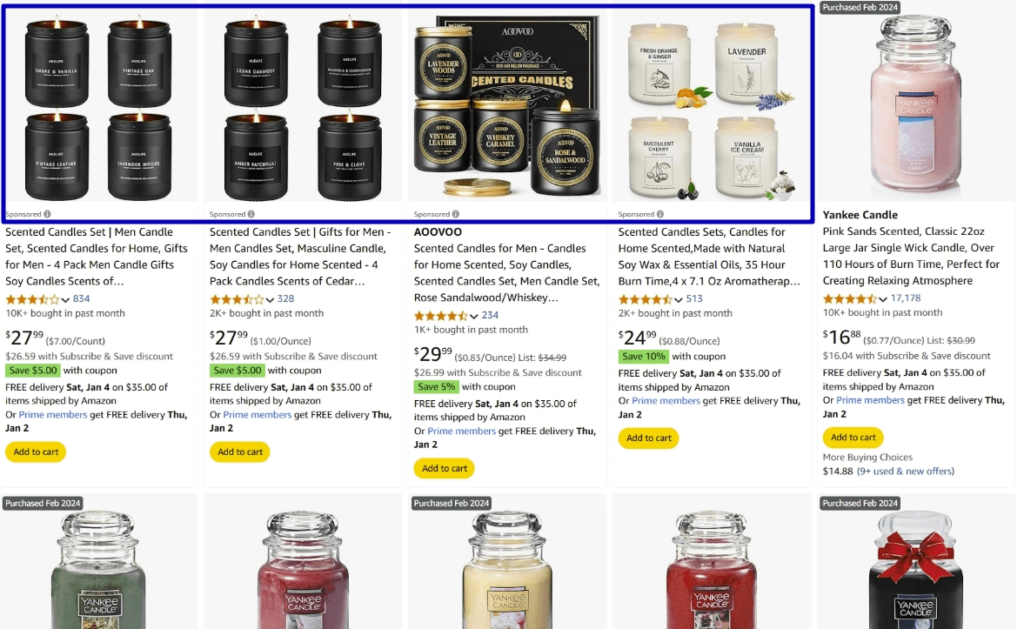
Why is this form so crucial for Amazon PPC campaign design? Well, they’re particularly effective for targeting those in the buying phase of their customer journey. They’re searching for something specific, and your Sponsored Product can place you right in front of them, bypassing the organic competition. It makes this type pivotal for immediate sales, a significant objective for many ads.
Sponsored Brands
Sponsored Brands occupy prime real estate, often appearing at the top, middle, or bottom of search results. They’re more than just product ads; they’re brand placements that allow you to feature a custom headline, brand logo, and multiple products in a single ad space.
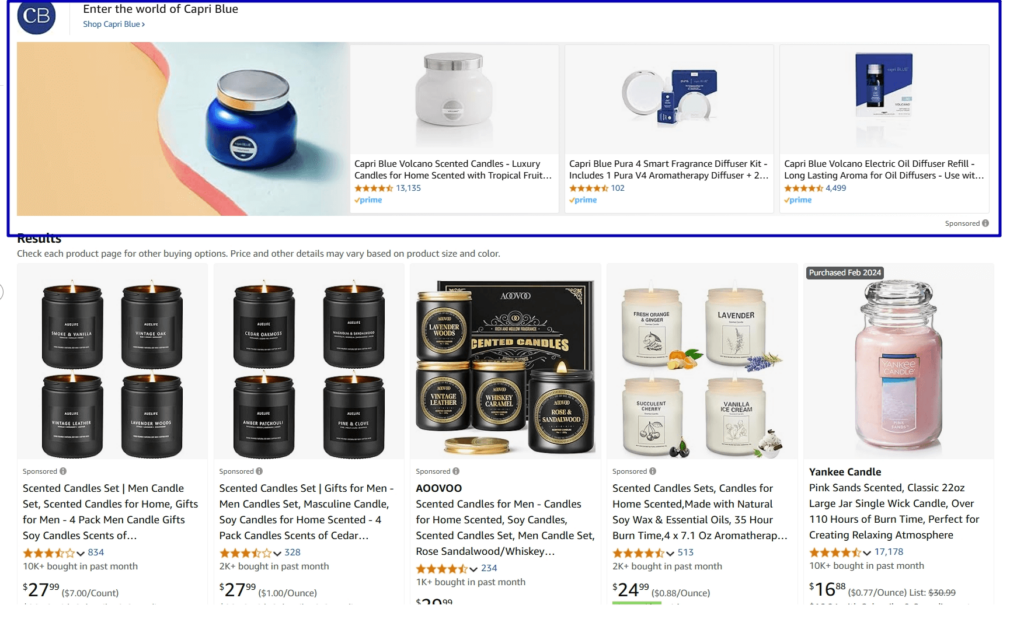
When thinking about Amazon PPC format, Sponsored Brands are your tool for brand awareness and recall. These displays are not just about immediate sales; they introduce your brand to the consumer, offering a longer-term plan to create loyal shoppers. Their strategic placement and branding potential mean they’re superb for sellers looking to elevate their brand as a whole in the marketplace.
Sponsored Display
Sponsored Display placements venture outside of Amazon’s platform, allowing you to capture customer attention wherever they are online. They can appear on product detail pages, review pages, and even other websites and apps beyond the marketplace.
In terms of structuring your Amazon PPC campaign, Sponsored Display offers retargeting capabilities, allowing you to reconnect with consumers who’ve interacted with your products or similar categories before. This renders them indispensable for sustaining brand awareness and converting interest into sales. However, it is worth noting that this option doesn’t target keywords; instead, it’ll look at shopper behaviour to see who is interested in your products or category.
DSP (Demand Side Platform)
Amazon DSP is a more advanced solution for those who desire granular control over their campaigns. It allows you to buy display, video, and audio ads not just on the marketplace but across the web on third-party exchanges. This form can be used for anything from brand awareness to direct response campaigns.
When considering your overall set up, DSP allows for detailed targeting and optimisation that the other types can’t match. It’s excellent for well-defined, data-driven ads aiming to reach specific audiences.
TV Ads
Last but certainly not least, TV ads take your brand to the big screen. These aren’t just for massive companies; even smaller businesses can tap into TV advertising through Amazon. These can appear on streaming platforms and even on live TV.
Structuring your promotional efforts around TV Ads is undoubtedly ambitious but can pay off significantly in terms of mass exposure. These ads are about big-picture branding, massively amplifying and creating a holistic brand experience.
Summary Table: Choosing the Right Ad Type
| Ad Type | Best For | Advantages | Limitations |
| Sponsored Products | Immediate sales and new products with little organic traction | Show up seamlessly in search results and product pages | Limited branding as it focuses on a single product |
| Sponsored Brands | Brand recognition | Appear at the top, middle, or bottom of search results on relevant searches | Cost and brand registry requirement |
| Sponsored Display | Retargeting | Get in front of customers on and off the marketplace | Since it doesn’t target keywords, it might be less specific and you may spend more on irrelevant clicks |
| DSP | Advanced targeting | A flexible approach that allows display, video, and audio ads | Complexity and high budget |
| TV Ads | Mass exposure and high-impact branding | Create a brand experience and extend your reach directly into consumers’ living rooms | High cost and complex ROI tracking |
Setting Up Ad Groups: Broad, Phrase, and Exact Match
Alright, we’ve covered the foundation and the types of ‘materials’ you can use – now let’s talk about the walls and partitions, metaphorically speaking. In Amazon PPC campaign structure, ad groups are like the rooms in your house; they hold everything together in neat, organised spaces. You can set up multiple groups within a campaign, and each group can contain one or more keywords and the respective ads for those terms.
As also highlighted above, choosing the right kind of ‘match type’ for your terms in these ad groups is crucial for determining how closely the shopper’s search query should match your keywords. Let’s delve into what each match type means and how to best utilise them within your Amazon PPC framework.
Broad Match
Broad Match is the most lenient of the three match types. It allows your ads to appear for your targeted searches that include misspellings, synonyms, related searches, or other relevant variations. For example, if your phrase is ‘running shoes’, your ad could appear when someone searches for ‘jogging sneakers’ or ‘athletic footwear’.
In terms of campaign formation, Broad Match serves as an excellent scouting tool. Use it when you’re unsure which keywords will perform best or when you want to cast a wide net to capture various search queries. However, be cautious; Broad Match can often lead to irrelevant clicks, which could eat into your budget without converting into sales.
Phrase Match
Phrase Match is more refined. Your advertisement will appear when customers search for the precise keyword sequence you’ve entered, even if additional words precede or follow the phrase. For example, if your search term is ‘leather boots’, your promotion could show up for ‘black leather boots’ or ‘leather boots on sale’ but not for ‘boots made of leather’.
When structuring your campaign, Phrase Match is the middle-ground option. It offers a balance between reach and relevance, making it a valuable tool when you have some idea of what your potential customers are searching for but still want to leave room for variations.
Exact Match
With Exact Match, what you see is what you get. Your ad will only appear when someone searches for your exact search term in the same sequence you’ve entered it, with no additional words before, after, or in between. If your target words are ‘vegan protein powder’, your promotion won’t appear for ‘best vegan protein powder’ or ‘protein powder vegan’.
Regarding your Amazon PPC campaign structure, Exact Match is your sniper rifle. Use it when you know precisely what your potential buyers are typing into the search bar. It’s perfect for highly converting keywords where you want to maintain relevance.
Balancing Your Ad Groups
Understanding these match types is critical for structuring your ad groups efficiently. For instance, you might start with Broad Match phrases to explore various search queries, and then, as you gather data, you can refine these into Phrase Match or Exact Match keywords in separate groups. This gives you more control over your budget and enables more successful targeting.
Example: Let’s say you sell ‘organic skincare products’. A Broad Match ad group might include terms like ‘natural face cream’. In contrast, a Phrase Match group could contain ‘organic moisturiser for dry skin’, and an Exact Match group might specifically target ‘organic anti-ageing serum’.
By combining these match types thoughtfully within your ad groups, you create a robust Amazon PPC campaign construction that can capture a broad audience at first and then funnel down to more targeted, high-converting prospects.
Keyword Research and Selection: The Cornerstone of Your Amazon PPC Campaign Structure
We’ve laid the foundation, chosen our materials, and built the walls. Now, it’s time to talk about the decorations – the keywords that will attract visitors to each ‘room’ of your campaign. Choosing the right terms is like selecting the right kind of art for your walls. It needs not just to fit the room but also draw the eye and engage your guests.
Select Keywords of Similar Search Volume
When choosing target words for each ad group, think of it as curating a theme. Keywords in each group should share a similar search volume. Why does this matter? Well, imagine you mix high-volume terms like ‘laptops’ with a low-volume term like ‘budget gaming laptops under £500’ in the same group. The high-volume one will almost certainly hog your budget, soaking up all the impressions and leaving the low-volume words in the dust. While high-demand phrases are like magnets, attracting a lot of attention, they aren’t always useful. Getting many impressions is good, but you must find a balance to ensure they convert and offer the targeted results you want.
Mixing search volumes is a common mistake that can lead to a lot of wasted spend. So, while you can choose more competitive words, make sure you’re reserving a budget for low-competition, high-intent terms. This provides more meaningful data on each phrase’s performance, enabling better decision-making as you refine your Amazon PPC campaign format.
The Power of Negative Keywords
No, we’re not talking about pessimism here. In the realm of advertising, negative keywords are your guards at the door, ensuring that you don’t pay for clicks that have a low probability of converting into sales. They prevent your ads from showing up for particular phrases or words.
For instance, if you’re selling ‘premium coffee beans’, you might use ‘instant’ as a negative keyword to ensure you’re not wasting money on people looking for instant coffee. This tactic helps make each ad group within your campaign more targeted and, by extension, makes your entire set up more efficient.
Actionable Tip: Regularly review the ‘Search Term Reports’ on Amazon to identify irrelevant queries that have triggered your ads. Add these as negative terms to your campaign.
Optimising Your Campaigns: The Art of Fine-Tuning Your Amazon PPC Campaign Structure
Imagine you’ve built your dream home – a strong foundation, suitable materials, rooms defined, and decorations in place. Would you leave it to gather dust? Of course not. Similarly, once your Amazon PPC campaign structure is up and running, you can’t afford to leave it unattended. Instead, it requires regular maintenance and upgrades to keep it in top form. Here’s how to optimise your campaigns:
- Regularly Review Performance Metrics: Monitor click-through rates (CTR), conversion rates, and return on ad spend (ROAS) to gauge how well your campaign is performing. A well-designed campaign makes this easier by having each element – the ad types, groups, and keywords – neatly categorised for quick assessments.
- Seasonal Adjustments: Consumer behaviour changes with the seasons, holidays, or even days of the week. Consider adjusting your promotions to meet these fluctuating demands. If you’ve ordered your campaign with specificity, making these adjustments becomes much easier and more successful.
- Implement A/B Testing: An organised Amazon PPC campaign allows for more effective A/B testing. Since everything is well-organised, you can run tests on specific elements without affecting the entire format, allowing you to isolate variables and truly understand what’s working and what isn’t.
Monitoring and Adjusting for Better Results
Consistency is good, but rigidity in PPC is a no-go. Monitor your ads to identify high-performing and underperforming elements. Are certain keywords draining your budget without conversions? It might be time to move them to a separate ad group or cut them out entirely.
By the same token, if a particular group or type of ad performs spectacularly, consider increasing its budget. The great advantage of a planned campaign is that it makes these kinds of shifts easier to manage without unsettling the entire campaign.
Tools and Software to Assist in Optimisation
The market is replete with tools designed to help you optimise your Amazon PPC campaigns. Software like SellerApp, Helium 10, and Jungle Scout offer functionalities that can track performance metrics, suggest keywords, and even automate some elements of campaign management.
Having a robust set up in place means you can plug these tools in more efficiently, extracting maximum value from their features to fine-tune your campaigns.
Ultimately, optimisation isn’t a one-off event but an ongoing process. A pre-planned Amazon PPC campaign isn’t just easier to optimise; it’s designed to be optimised. The framework allows you to zoom in on individual elements without losing sight of the bigger picture, making the path to a high-ROI campaign clearer and more achievable.
The Future of Amazon PPC Campaign Structure: Charting Unexplored Territories
If one thing is inevitable in the world of e-commerce and digital marketing, it’s change. The landscape is constantly evolving, technologies advance, and consumer behaviours shift. Your advert set up isn’t just a monument; it’s a living, breathing entity that must adapt to survive and thrive. So, let’s peer into the crystal ball and see what the future might hold for these ads.
- AI and Machine Learning: These technologies are only going to become more integral to the ad set up process. Algorithms are getting smarter, meaning campaigns will become more complex. You’ll want an adaptable design to take advantage of these automated tools without getting lost in the noise.
- Voice Search: As voice-activated devices like Amazon Echo become more common, voice search is likely to change the kinds of keywords that are successful. A flexible formation allows you to adapt to these new types of phrases quickly.
- Video: As internet speeds increase and attention spans decrease, video promotions are expected to become more prevalent. Your campaign arrangement should have the flexibility to incorporate new formats as they become available.
How to Stay Ahead of the Curve
While there are many trends to be aware of, you can stay ahead of these changes with a few simple steps.
- Continuous Learning: The advertising world is fast-paced. Staying up-to-date with industry blogs, webinars, and courses is essential. The better educated you are, the more proactively you can adapt your set up to new trends.
- Be Agile: The future will belong to agile marketers who can respond quickly to new data and evolving landscapes. Use the structural integrity you’ve built into your campaign as a springboard for innovation, not as a crutch that holds you back.
- Networking and Communities: Joining Amazon seller communities and forums can provide insider tips and first-hand accounts of what’s working and what’s not. This can be an invaluable asset in future-proofing your campaigns.
Outsourcing Amazon PPC Campaign Management: Choose NUOPTIMA as Your Trusted Partner
We’ve covered a lot in this guide to mastering Amazon PPC campaign structure. However, navigating the ad complexities can feel like a full-time job. Just when you think you’ve cracked the code, the rules change. That’s where NUOPTIMA comes in, offering a strategic edge through outsourcing your Amazon PPC management.
Here’s why we’re the partner you’ve been searching for:
- Agile and Adaptive: We quickly adapt to the marketplace’s ever-changing landscape, ensuring your PPC campaigns are always one step ahead.
- Expertise Where It Matters: We apply our in-depth knowledge of Amazon PPC campaign design to maximise your visibility and sales.
- Proactive, Not Reactive: We anticipate marketplace trends, keeping your campaigns optimised and ahead of the curve.
- A Team of Amazon Pros: Our seasoned managers understand the platform’s unique landscape, helping your brand carve its niche.
- Tailored Approach: We don’t do one-size-fits-all. Our team crafts bespoke Amazon PPC strategies that align with your brand’s specific goals.
- A True Partnership: Consider us an extension of your brand. We’re committed to maintaining an organised, effective PPC campaign that mirrors your vision and objectives.
In short, NUOPTIMA offers growth-focused Amazon PPC management. Whether you’re refining existing campaigns or starting afresh, we focus on sustainable scaling tailored to your brand.
Ready to take the Amazon marketplace by storm? Let NUOPTIMA be your guide. Reach out, and let’s achieve great things together.
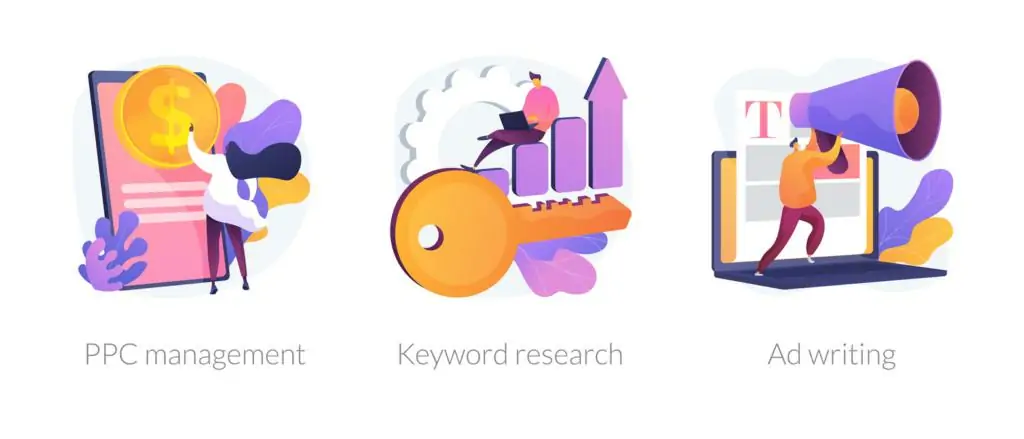
Conclusion: The Power of an Organised Amazon PPC Campaign
Navigating the world of advertising can seem daunting, but as we’ve explored, the rewards are worth the effort. A pre-planned PPC campaign is not just a nice-to-have but a must-have for any serious seller. From the types of ad groups and campaigns to keyword selection and optimisation strategies, every detail matters.
The landscape of PPC is ever-changing, and to stay competitive, continuous learning and adaptation are essential. Whether you do it alone or choose a trusted partner like NUOPTIMA, remember that the journey to advertising success is a marathon, not a sprint.
Ready to elevate your Amazon PPC game? Book a call with us, and let’s plot your roadmap to sustained, scalable growth.
FAQ
The three primary types of Amazon PPC campaigns are Sponsored Products, Sponsored Brands, and Sponsored Displays. Each offers unique opportunities for visibility and targeting, and the choice depends on your specific objectives and budget.
Structuring a campaign involves multiple steps, including deciding the campaign type (automatic or manual), setting up ad groups (Broad, Phrase, Exact), and selecting relevant keywords. Budget allocation and tracking metrics are also essential aspects of an organised campaign.
A PPC campaign on Amazon consists of one or more ad groups, each containing a set of keywords and the associated bids. Campaigns are managed from Amazon’s Seller Central dashboard, where you can monitor performance metrics, adjust settings, and optimise for better results.
KPI stands for Key Performance Indicator. In Amazon PPC, common KPIs include Click-Through Rate (CTR), Conversion Rate, Cost Per Click (CPC), and Advertising Cost of Sale (ACoS). Monitoring these metrics allows you to gauge campaign effectiveness and make informed adjustments.
